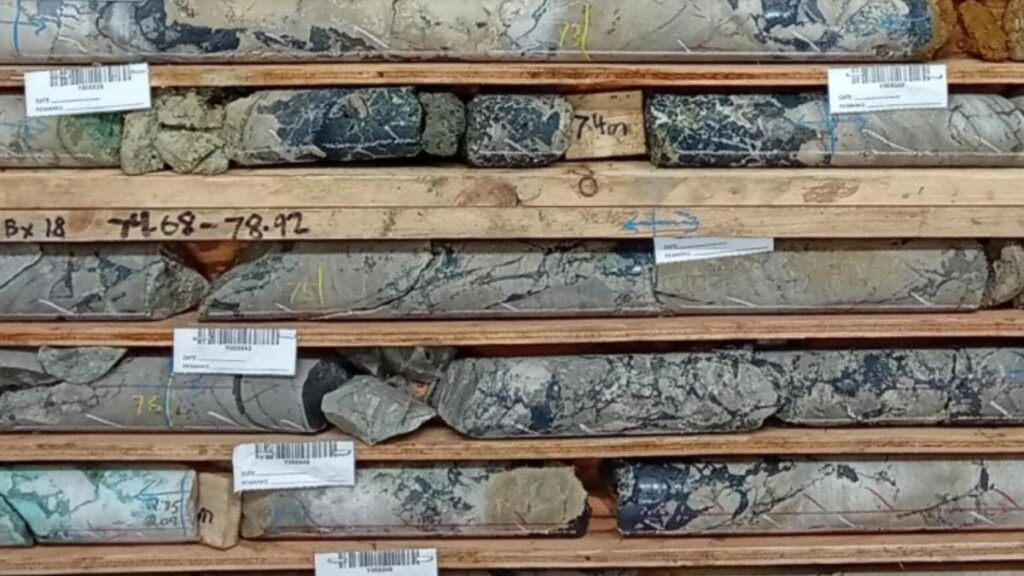American West Metals is rapidly developing its Storm copper project, northern Canada’s only near-term copper development, where the company’s geotechnical drilling has intersected thick copper sulphide zones.
The project, on Crown land in the territory of Nunavut, is a key asset in the nation’s critical minerals strategy.
American West says it is aggressively progressing Storm from historical survey work and geochemical anomalies, through a March preliminary economic assessment, towards a robust development proposal.
Between 1996 and 2000, surface geochemistry and drilling by mining giant Cominco Limited identified high-grade copper anomalies and mineralised zones such as 2.45 per cent copper along about 110 metres, establishing the project’s potential.
American West kicked off more modern exploration in 2021 to leverage historical data with ore sorting tests and surface sampling. Its work confirmed high-grade copper with a 53.9 per cent direct shipping ore (DSO) grade.
Within four years of its investment, American West has progressed towards this year achieving a pre-feasibility study and permitting, which highlights the company’s rapid pace of discovery and development.
The project’s expansion across a major graben, to include projects such as Cyclone, Chinook and discoveries such as Squall, supports Storm’s potential for further growth and possible aggregation.
The ongoing pre-feasibility study and permitting activities underscore Storm’s potential as a near-term copper producer with significant geopolitical importance. American West’s recent field activities included geotechnical drilling, environmental studies and archaeological surveys.
Seven geotechnical diamond drill holes to target proposed open-pit walls at the Cyclone and Chinook deposits have intersected thick intervals of visible copper sulphide mineralisation.
The first diamond drill hole on the southern margin of the company’s Cyclone deposit encountered 43m of sulphide mineralisation across five zones – from 29-47m, 51-53m, 57-61m, 65-76m and 83-91m – including semi-massive sulphides showing chalcocite, chalcopyrite and pyrite.
A second diamond hole on the northern graben margin intersected 47m of mineralisation across three zones – from 51-67m, 70.5-83m and 98-119m – primarily in stratabound chalcocite.
Notably, these thick zones lie well outside Storm’s current mineral resource estimate, signalling strong potential for resource expansion. American West expects to receive assay results from the holes within two to three weeks, which should largely confirm its visual estimations.
With the robust economics and strong upside presented by the PEA released in March this year, American West elected to progress a pre-feasibility study with the aim of fast tracking and derisking the development option for the Storm project. An important part of this PFS work was to address any gaps in the field aspects of the study and this year’s program has been designed to aggressively move the PFS forward.
The company’s environmental work continues, and it is working on marine and wildlife surveys in Aston Bay that consider fish habitat, freshwater studies and project-wide terrestrial wildlife assessments. These studies will form the basis of its upcoming environmental assessment (EA) documentation.
Community engagement and archaeological surveys within the project area have also been completed, refining American West’s environmental and project management plans.
The company has made two submissions to the Nunavut Planning Commission: one to extend its exploration activities, including a winter road, while another submission outlines its proposed mine and mill complex for future mining licence applications.
American West also has metallurgical test work underway to optimise its processing circuit, focusing on grinding and sizing, variability studies and advanced beneficiation technologies, such as ore sorting and heavy media separation. These studies aim to boost the project’s copper and silver recoveries while reducing its capital costs.
Its geotechnical studies are assessing pit-slope angles and ramp designs, while its capital and operating cost estimates are being refined with contractor quotes.
Canada’s critical minerals strategy, reinforced by its 2025 Resource Project Fast-Track Bill, prioritised Storm’s development as a nationally strategic project.
Canada wants to facilitate domestic mineral production to the maximum possible extent. Its fast-track legislation streamlines permitting for critical mineral projects and has allocated more than C$2 billion (A$2.23 billion) to support local mining initiatives.
Storm’s high environmental, social and governance credentials, innovative processing and strong community relationships position it for easier access to these funding opportunities and will enhance its role in Canada’s economic and geopolitical landscape.
With mineralisation spanning a major graben, Storm’s prospects at Cyclone, Chinook, and other targets show considerable potential for lateral and depth expansion, some of which might coalesce into bigger aggregations.
The project’s strategic location and robust economics, supported by partners Taurus, which is providing royalty finance, and Ocean Partners, with its offtake and financing deals, make it a cornerstone of Canada’s critical minerals supply chain.
American West is charging towards production at Storm, with thick visible copper sulphide intersections in geotechnical drilling signalling significant possible resource upside. Storm’s vast mineralised system across the 1 to 2 kilometres-wide Central Graben at Nunavut positions it as a potential global copper powerhouse.
Is your ASX-listed company doing something interesting? Contact: [email protected]
https://thewest.com.au/business/bulls-n-bears/american-west-pushes-pfs-work-on-near-term-canadian-copper-project-c-19797879


